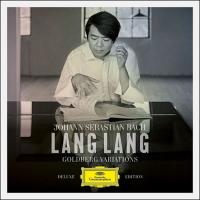Lang Lang—The Classical Music Superstar Critics Love to Hate Hate Delivers his "Goldberg Variations"
He no doubt knew the critics would pounce given his predilection for drama, and they did but he recorded and released it anyway in two versions, one performed live before an audience at the St. Thomas church in Leipzig, Germany where Bach toiled for his final 27 years, and one in Berlin's Emil Berliner studios. Deutsche Grammophon released it as a 4 CD deluxe set containing both live and studio versions and as a double LP of just the live "one take" performance. Though it was written for harpsichord, most modern recordings are performed on the piano. The CD set includes photos of Lang Lang his critics will say show him "mugging" for the camera though classical music artists and conductors have been doing this throughout the history of recorded classical music. A few picture him gesticulating, eyes closed, in front of stereo system that includes a Revox B77 reel-to-reel tape recorder, a high quality turntable I can't identify and a vacuum tube amplifier, though inexplicably, that photo was omitted from the LP set.
Glenn Gould's rapid fire 1955 performance is considered by many to be the best on record, but of course critics and fans have a wide range of favorites, including some who prefer Keith Jarrett's performed on harpsichord. You are not reading a review written by a classical music expert capable of dissecting and comparing what Lang Lang has produced here to the others, though I own and enjoy listening to a number of other performances including both of Gould's. I admit to not analyzing and dissecting. You can search online and read the many scathing critiques of this release including one from The New York Times's classical music critic Anthony Tommasini titled “Lang Lang: The Pianist Who Plays Too Muchly”, who like most of the others, faints with damn praise Lang Lang's talent ("...for all his playing’s uncanny virtuosity, wondrous control of shadings and sound and unbridled urgency — I and many others have long found Mr. Lang’s performances overindulgently expressive and marred by exaggerated interpretive touches".). Having established that groundwork, Tommasini digs into Lang Lang's studio performance, concluding that "for all the soft-spoken beauty of his performance, it comes across as fussy and affected". I'm surprised he didn't criticize the pianist for not having candelabras on the piano and a brother named George playing the violin. I too can be bitchy! And while I'm at it, let me criticize Mr. Tommasini for this: though he often writes in great detail about concert hall sound—places that 95% of readers have never and will never visit, when he reviews recordings he never mentions sound quality! How "muchly" fucked up is that? Pardon my language (or don't).
However, Mr. Tommasini does a great service in his review, which you should read, by embedding excerpts from Lang Lang's performance and that of two others, Jeremy Denk and Beatrice Rana. You can listen and judge for yourself to what degree Lang Lang's interpretation is deserving of such derision! Other reviews are equally dismissive and use the same technique: admit to great talent and abilities and then attack the ripe target.
Writing as a "non-combatant" in this war and as a more casual classical music lover, and without comparing this performance (or these performances) to any others, I can confidently write that I listened numerous times to these performances streamed, on CD and the live version on the double vinyl LP. That's a lot of listening and a great deal of enjoyment.
Somehow as a casual observer I didn't notice that Lang Lang "yanked around" the music and made it sound "labored" or that his constant use of "...cresendos that swell and subside, like a squeeze box" make the performance sound "fussy". Ignorance is bliss because as I sat listening I marveled at the musician's dexterity as his fingers flew across the keyboard and it certainly wasn't boring or "over the top" self-indulgent. Instead, it was Lang Lang’s (Mr. Lang’s?) interpretation for his 21st century adoring fanbase. What can be wrong with that other his popularity, which must gall some? Yes, even I noticed a more "ripe" posture to some of it compared to more staid performances, but so what?
Being an audio enthusiast too, I'll give you my sonic experiences, which I found fascinating and for some of you will simply sound self-fulfilling. The 44.1/16 bit CD version was, well “CD”— where the edges were too bright, where the piano’s “woody” quality was lost and where the reverberant space was co-mingled with the instrument’s reverberant character. I didn’t enjoy listening to the CD (no great surprise).
The TIDAL MQA streamed 96/24 version was like another recording altogether. The piano sounded more like a piano made of wood. The church space on the live performance was well-separated from the instrument and it was overall far more coherent and satisfying. I don’t understand those who are MQA resistant especially those who view it as a “plot” to control their recorded musical existence.
And, not surprising (to me at least), the extremely well mastered and flawlessly pressed vinyl record sounded very much like the MQA 96/24 stream. While Lang Lang himself expressed a preference for the studio version, in part probably because it is more technically perfect, the live version has greater excitement and immediacy and the church space enhances the listening experience by putting you in that space in the audience. The vinyl version is the studio recording not the live one.
If it takes Lang Lang to get some of his fans to move from romance to the more subtle and less grand but more satisfying over the long haul “Goldberg Variations”, where’s the harm in playing a bit “muchly”?


